Patanjali Ayurved Limited: A Detailed Corporate Strategy Analysis
VerifiedAdded on 2020/03/16
|21
|4450
|1437
Report
AI Summary
This report offers a comprehensive strategic analysis of Patanjali Ayurved Limited, an Indian FMCG company. It begins with an introduction and then delves into the external environment using PESTEL and Porter's Five Forces models, identifying opportunities and threats. Scenario planning and an examination of the company's resources and capabilities, including a VRIN analysis, are also included. The report explores business-level and corporate-level strategies, utilizing the Ansoff Matrix. Finally, it discusses potential growth opportunities and concludes with recommendations. The analysis covers various aspects of the company's operations, providing insights into its market position and future prospects.
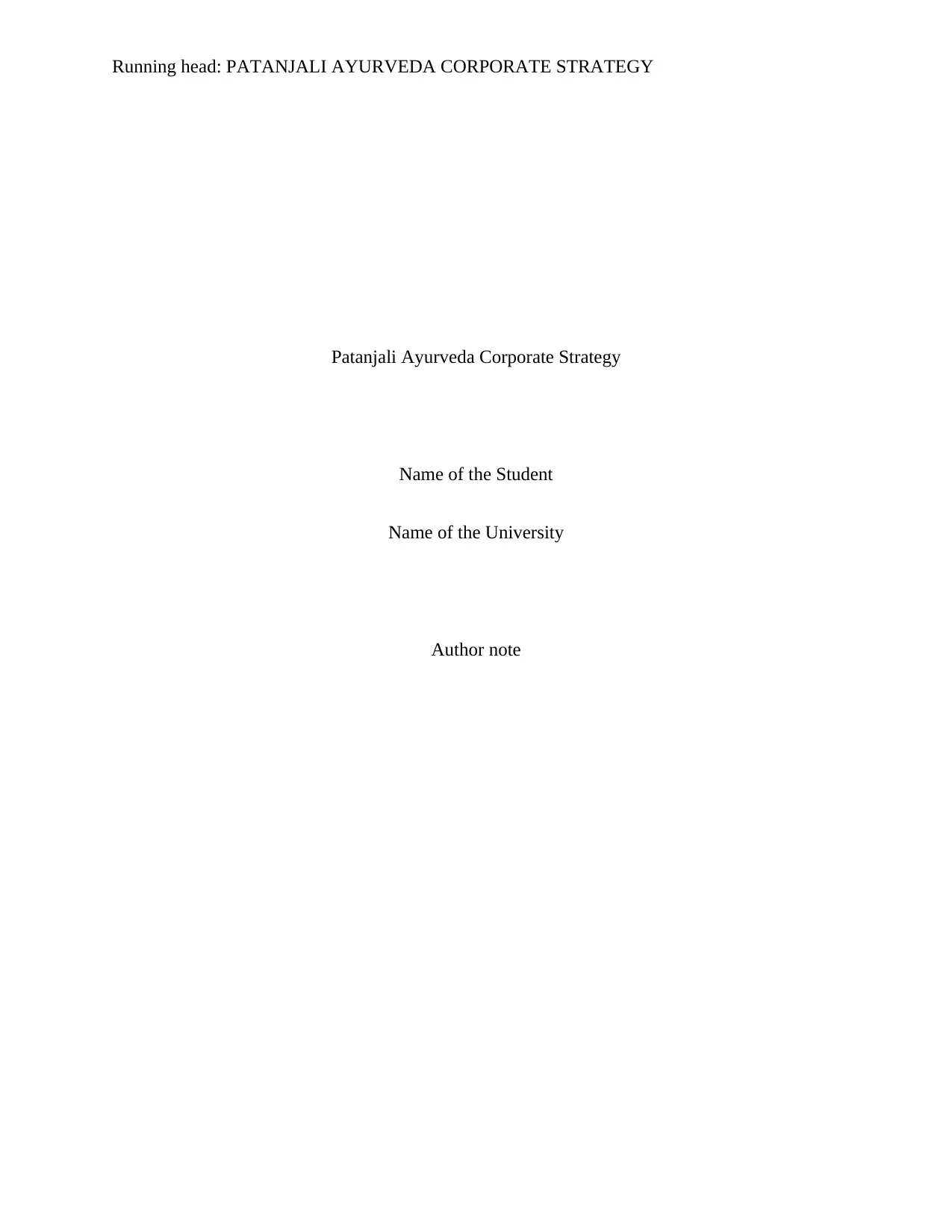
Running head: PATANJALI AYURVEDA CORPORATE STRATEGY
Patanjali Ayurveda Corporate Strategy
Name of the Student
Name of the University
Author note
Patanjali Ayurveda Corporate Strategy
Name of the Student
Name of the University
Author note
Paraphrase This Document
Need a fresh take? Get an instant paraphrase of this document with our AI Paraphraser
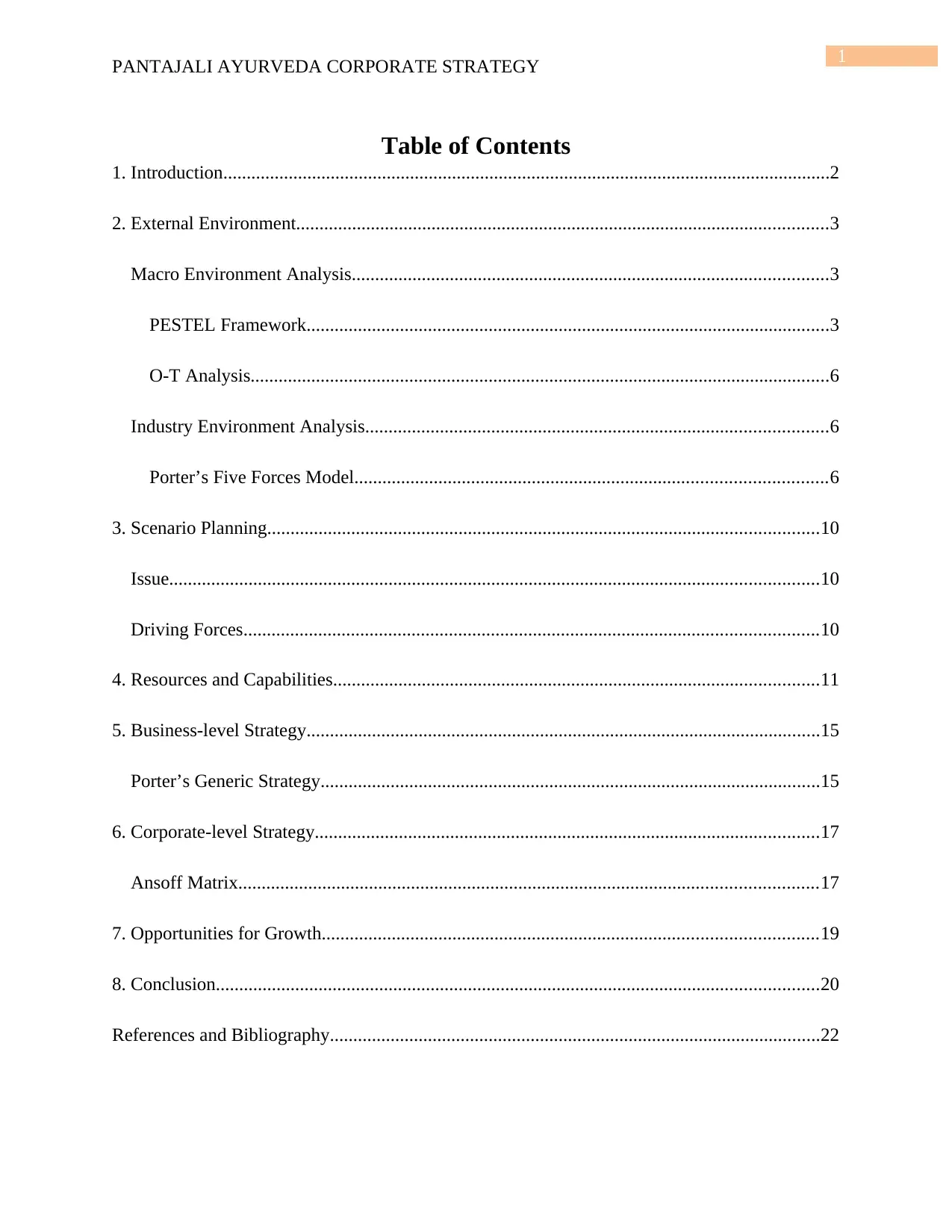
1
PANTAJALI AYURVEDA CORPORATE STRATEGY
Table of Contents
1. Introduction..................................................................................................................................2
2. External Environment..................................................................................................................3
Macro Environment Analysis......................................................................................................3
PESTEL Framework................................................................................................................3
O-T Analysis............................................................................................................................6
Industry Environment Analysis...................................................................................................6
Porter’s Five Forces Model.....................................................................................................6
3. Scenario Planning......................................................................................................................10
Issue...........................................................................................................................................10
Driving Forces...........................................................................................................................10
4. Resources and Capabilities........................................................................................................11
5. Business-level Strategy..............................................................................................................15
Porter’s Generic Strategy...........................................................................................................15
6. Corporate-level Strategy............................................................................................................17
Ansoff Matrix............................................................................................................................17
7. Opportunities for Growth..........................................................................................................19
8. Conclusion.................................................................................................................................20
References and Bibliography.........................................................................................................22
PANTAJALI AYURVEDA CORPORATE STRATEGY
Table of Contents
1. Introduction..................................................................................................................................2
2. External Environment..................................................................................................................3
Macro Environment Analysis......................................................................................................3
PESTEL Framework................................................................................................................3
O-T Analysis............................................................................................................................6
Industry Environment Analysis...................................................................................................6
Porter’s Five Forces Model.....................................................................................................6
3. Scenario Planning......................................................................................................................10
Issue...........................................................................................................................................10
Driving Forces...........................................................................................................................10
4. Resources and Capabilities........................................................................................................11
5. Business-level Strategy..............................................................................................................15
Porter’s Generic Strategy...........................................................................................................15
6. Corporate-level Strategy............................................................................................................17
Ansoff Matrix............................................................................................................................17
7. Opportunities for Growth..........................................................................................................19
8. Conclusion.................................................................................................................................20
References and Bibliography.........................................................................................................22
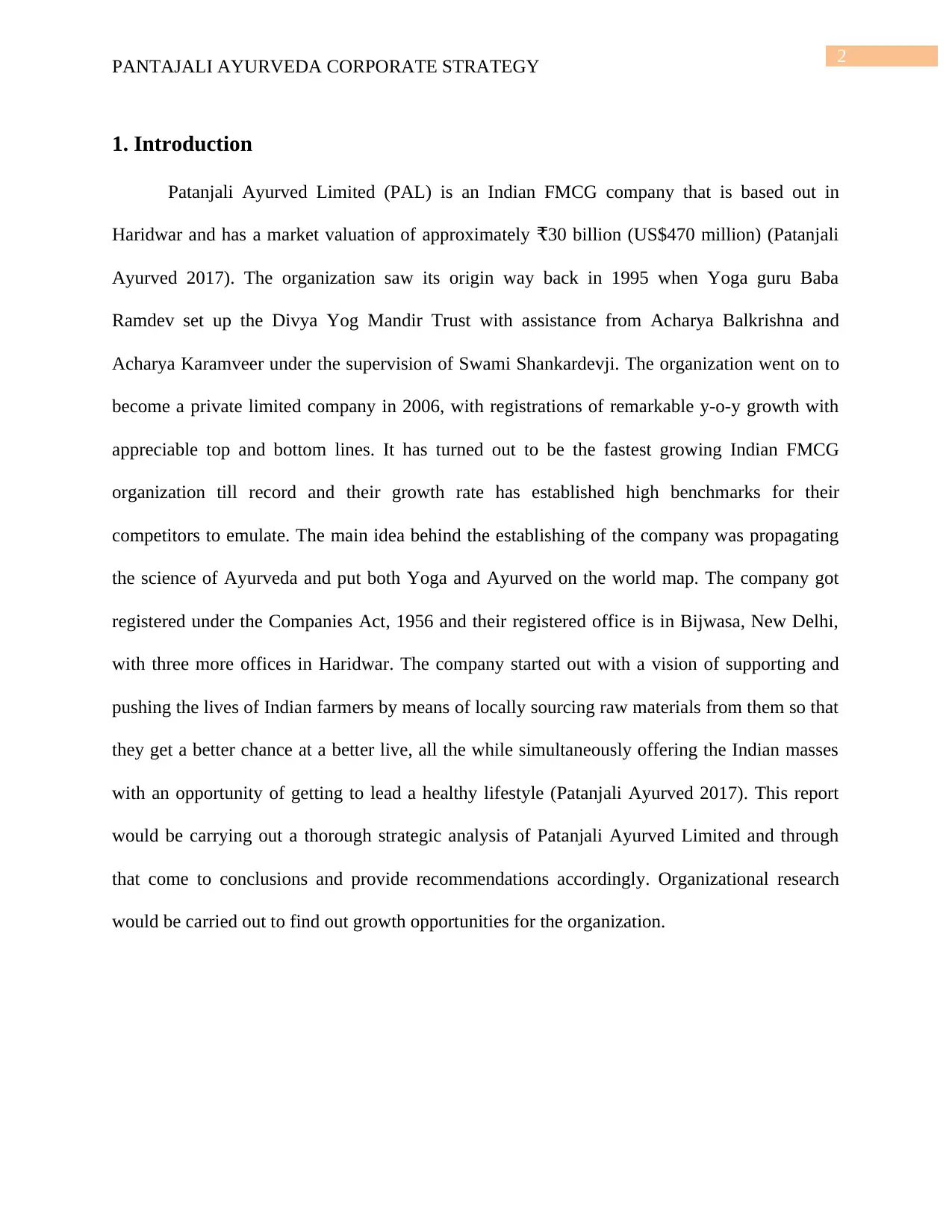
2
PANTAJALI AYURVEDA CORPORATE STRATEGY
1. Introduction
Patanjali Ayurved Limited (PAL) is an Indian FMCG company that is based out in
Haridwar and has a market valuation of approximately 30 billion (US$470 million) (Patanjali₹
Ayurved 2017). The organization saw its origin way back in 1995 when Yoga guru Baba
Ramdev set up the Divya Yog Mandir Trust with assistance from Acharya Balkrishna and
Acharya Karamveer under the supervision of Swami Shankardevji. The organization went on to
become a private limited company in 2006, with registrations of remarkable y-o-y growth with
appreciable top and bottom lines. It has turned out to be the fastest growing Indian FMCG
organization till record and their growth rate has established high benchmarks for their
competitors to emulate. The main idea behind the establishing of the company was propagating
the science of Ayurveda and put both Yoga and Ayurved on the world map. The company got
registered under the Companies Act, 1956 and their registered office is in Bijwasa, New Delhi,
with three more offices in Haridwar. The company started out with a vision of supporting and
pushing the lives of Indian farmers by means of locally sourcing raw materials from them so that
they get a better chance at a better live, all the while simultaneously offering the Indian masses
with an opportunity of getting to lead a healthy lifestyle (Patanjali Ayurved 2017). This report
would be carrying out a thorough strategic analysis of Patanjali Ayurved Limited and through
that come to conclusions and provide recommendations accordingly. Organizational research
would be carried out to find out growth opportunities for the organization.
PANTAJALI AYURVEDA CORPORATE STRATEGY
1. Introduction
Patanjali Ayurved Limited (PAL) is an Indian FMCG company that is based out in
Haridwar and has a market valuation of approximately 30 billion (US$470 million) (Patanjali₹
Ayurved 2017). The organization saw its origin way back in 1995 when Yoga guru Baba
Ramdev set up the Divya Yog Mandir Trust with assistance from Acharya Balkrishna and
Acharya Karamveer under the supervision of Swami Shankardevji. The organization went on to
become a private limited company in 2006, with registrations of remarkable y-o-y growth with
appreciable top and bottom lines. It has turned out to be the fastest growing Indian FMCG
organization till record and their growth rate has established high benchmarks for their
competitors to emulate. The main idea behind the establishing of the company was propagating
the science of Ayurveda and put both Yoga and Ayurved on the world map. The company got
registered under the Companies Act, 1956 and their registered office is in Bijwasa, New Delhi,
with three more offices in Haridwar. The company started out with a vision of supporting and
pushing the lives of Indian farmers by means of locally sourcing raw materials from them so that
they get a better chance at a better live, all the while simultaneously offering the Indian masses
with an opportunity of getting to lead a healthy lifestyle (Patanjali Ayurved 2017). This report
would be carrying out a thorough strategic analysis of Patanjali Ayurved Limited and through
that come to conclusions and provide recommendations accordingly. Organizational research
would be carried out to find out growth opportunities for the organization.
⊘ This is a preview!⊘
Do you want full access?
Subscribe today to unlock all pages.

Trusted by 1+ million students worldwide
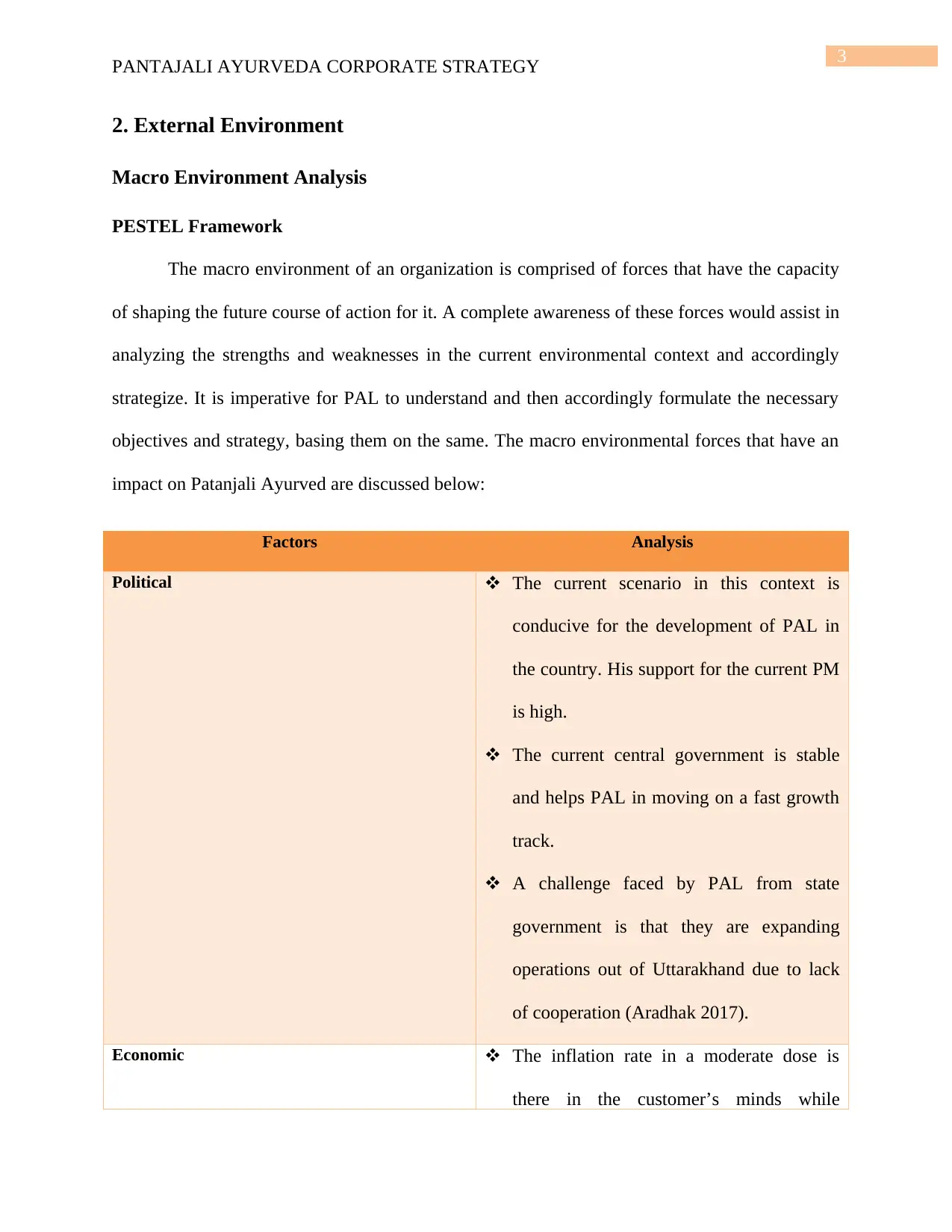
3
PANTAJALI AYURVEDA CORPORATE STRATEGY
2. External Environment
Macro Environment Analysis
PESTEL Framework
The macro environment of an organization is comprised of forces that have the capacity
of shaping the future course of action for it. A complete awareness of these forces would assist in
analyzing the strengths and weaknesses in the current environmental context and accordingly
strategize. It is imperative for PAL to understand and then accordingly formulate the necessary
objectives and strategy, basing them on the same. The macro environmental forces that have an
impact on Patanjali Ayurved are discussed below:
Factors Analysis
Political The current scenario in this context is
conducive for the development of PAL in
the country. His support for the current PM
is high.
The current central government is stable
and helps PAL in moving on a fast growth
track.
A challenge faced by PAL from state
government is that they are expanding
operations out of Uttarakhand due to lack
of cooperation (Aradhak 2017).
Economic The inflation rate in a moderate dose is
there in the customer’s minds while
PANTAJALI AYURVEDA CORPORATE STRATEGY
2. External Environment
Macro Environment Analysis
PESTEL Framework
The macro environment of an organization is comprised of forces that have the capacity
of shaping the future course of action for it. A complete awareness of these forces would assist in
analyzing the strengths and weaknesses in the current environmental context and accordingly
strategize. It is imperative for PAL to understand and then accordingly formulate the necessary
objectives and strategy, basing them on the same. The macro environmental forces that have an
impact on Patanjali Ayurved are discussed below:
Factors Analysis
Political The current scenario in this context is
conducive for the development of PAL in
the country. His support for the current PM
is high.
The current central government is stable
and helps PAL in moving on a fast growth
track.
A challenge faced by PAL from state
government is that they are expanding
operations out of Uttarakhand due to lack
of cooperation (Aradhak 2017).
Economic The inflation rate in a moderate dose is
there in the customer’s minds while
Paraphrase This Document
Need a fresh take? Get an instant paraphrase of this document with our AI Paraphraser
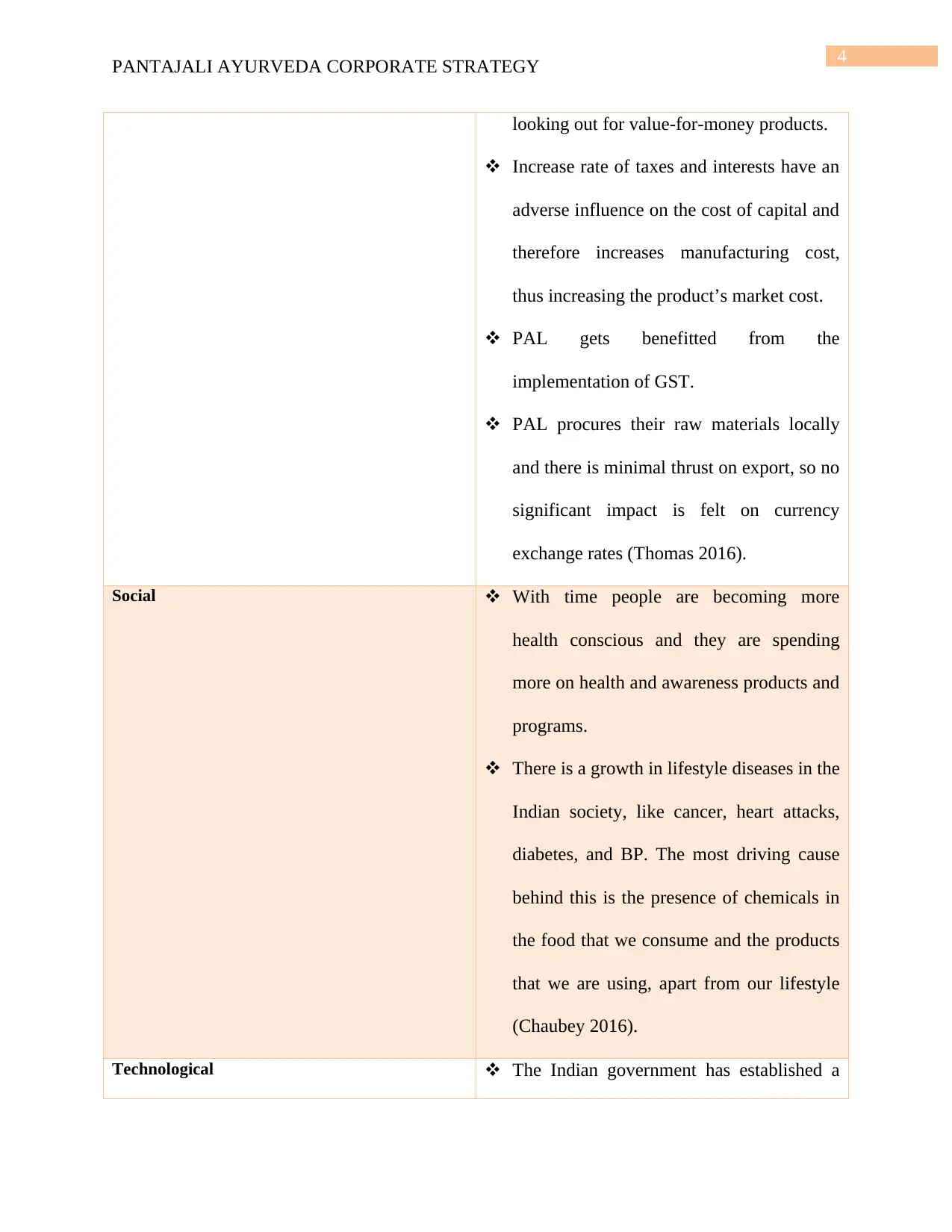
4
PANTAJALI AYURVEDA CORPORATE STRATEGY
looking out for value-for-money products.
Increase rate of taxes and interests have an
adverse influence on the cost of capital and
therefore increases manufacturing cost,
thus increasing the product’s market cost.
PAL gets benefitted from the
implementation of GST.
PAL procures their raw materials locally
and there is minimal thrust on export, so no
significant impact is felt on currency
exchange rates (Thomas 2016).
Social With time people are becoming more
health conscious and they are spending
more on health and awareness products and
programs.
There is a growth in lifestyle diseases in the
Indian society, like cancer, heart attacks,
diabetes, and BP. The most driving cause
behind this is the presence of chemicals in
the food that we consume and the products
that we are using, apart from our lifestyle
(Chaubey 2016).
Technological The Indian government has established a
PANTAJALI AYURVEDA CORPORATE STRATEGY
looking out for value-for-money products.
Increase rate of taxes and interests have an
adverse influence on the cost of capital and
therefore increases manufacturing cost,
thus increasing the product’s market cost.
PAL gets benefitted from the
implementation of GST.
PAL procures their raw materials locally
and there is minimal thrust on export, so no
significant impact is felt on currency
exchange rates (Thomas 2016).
Social With time people are becoming more
health conscious and they are spending
more on health and awareness products and
programs.
There is a growth in lifestyle diseases in the
Indian society, like cancer, heart attacks,
diabetes, and BP. The most driving cause
behind this is the presence of chemicals in
the food that we consume and the products
that we are using, apart from our lifestyle
(Chaubey 2016).
Technological The Indian government has established a
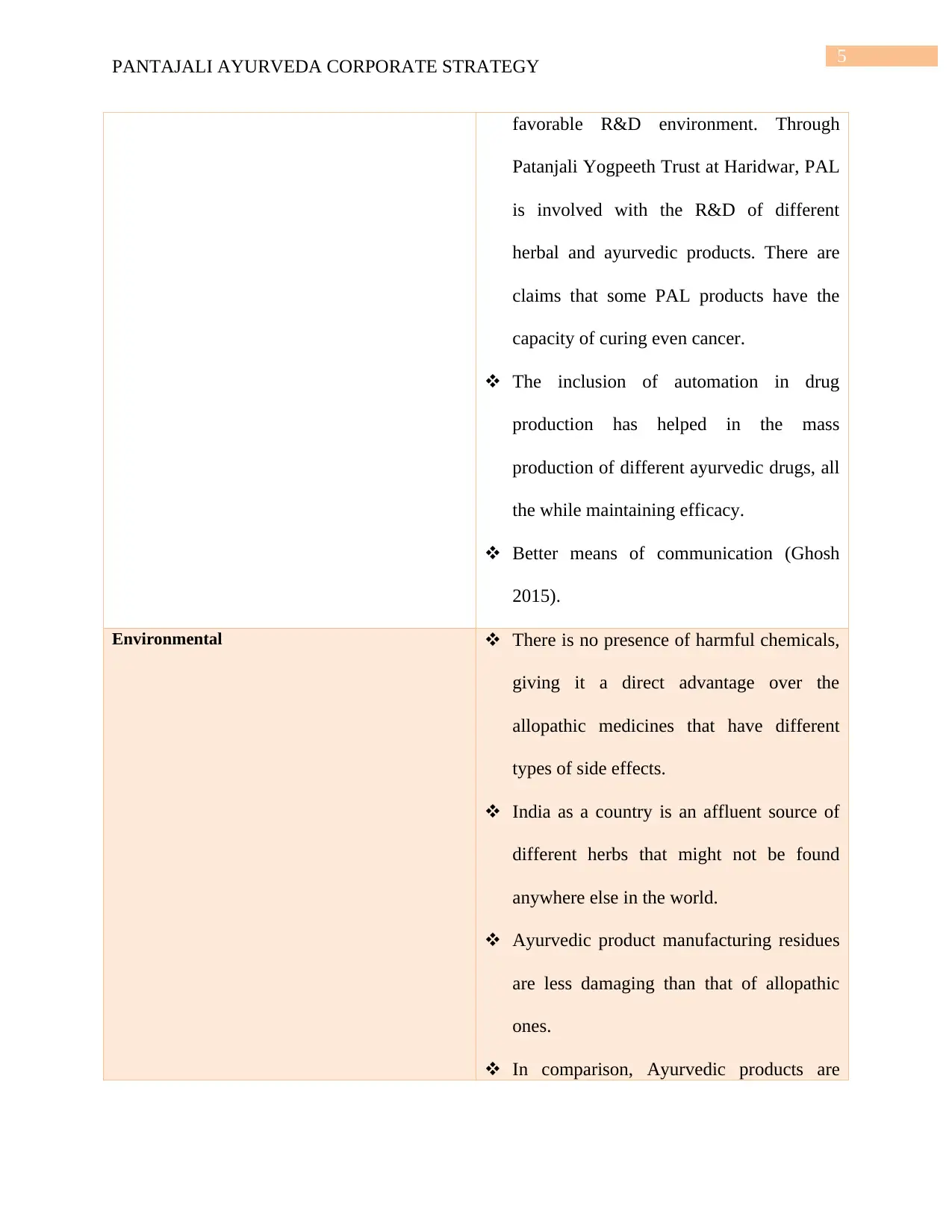
5
PANTAJALI AYURVEDA CORPORATE STRATEGY
favorable R&D environment. Through
Patanjali Yogpeeth Trust at Haridwar, PAL
is involved with the R&D of different
herbal and ayurvedic products. There are
claims that some PAL products have the
capacity of curing even cancer.
The inclusion of automation in drug
production has helped in the mass
production of different ayurvedic drugs, all
the while maintaining efficacy.
Better means of communication (Ghosh
2015).
Environmental There is no presence of harmful chemicals,
giving it a direct advantage over the
allopathic medicines that have different
types of side effects.
India as a country is an affluent source of
different herbs that might not be found
anywhere else in the world.
Ayurvedic product manufacturing residues
are less damaging than that of allopathic
ones.
In comparison, Ayurvedic products are
PANTAJALI AYURVEDA CORPORATE STRATEGY
favorable R&D environment. Through
Patanjali Yogpeeth Trust at Haridwar, PAL
is involved with the R&D of different
herbal and ayurvedic products. There are
claims that some PAL products have the
capacity of curing even cancer.
The inclusion of automation in drug
production has helped in the mass
production of different ayurvedic drugs, all
the while maintaining efficacy.
Better means of communication (Ghosh
2015).
Environmental There is no presence of harmful chemicals,
giving it a direct advantage over the
allopathic medicines that have different
types of side effects.
India as a country is an affluent source of
different herbs that might not be found
anywhere else in the world.
Ayurvedic product manufacturing residues
are less damaging than that of allopathic
ones.
In comparison, Ayurvedic products are
⊘ This is a preview!⊘
Do you want full access?
Subscribe today to unlock all pages.

Trusted by 1+ million students worldwide
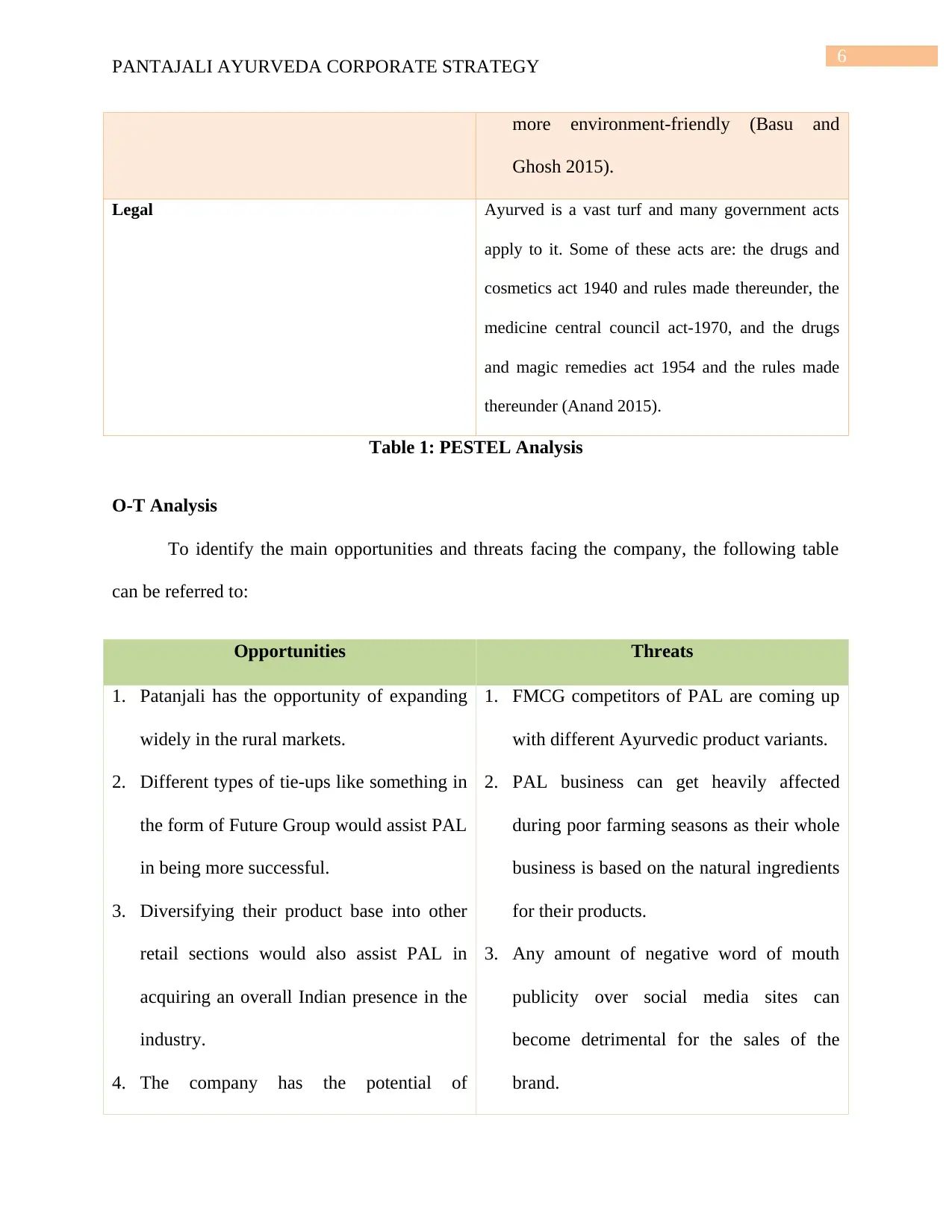
6
PANTAJALI AYURVEDA CORPORATE STRATEGY
more environment-friendly (Basu and
Ghosh 2015).
Legal Ayurved is a vast turf and many government acts
apply to it. Some of these acts are: the drugs and
cosmetics act 1940 and rules made thereunder, the
medicine central council act-1970, and the drugs
and magic remedies act 1954 and the rules made
thereunder (Anand 2015).
Table 1: PESTEL Analysis
O-T Analysis
To identify the main opportunities and threats facing the company, the following table
can be referred to:
Opportunities Threats
1. Patanjali has the opportunity of expanding
widely in the rural markets.
2. Different types of tie-ups like something in
the form of Future Group would assist PAL
in being more successful.
3. Diversifying their product base into other
retail sections would also assist PAL in
acquiring an overall Indian presence in the
industry.
4. The company has the potential of
1. FMCG competitors of PAL are coming up
with different Ayurvedic product variants.
2. PAL business can get heavily affected
during poor farming seasons as their whole
business is based on the natural ingredients
for their products.
3. Any amount of negative word of mouth
publicity over social media sites can
become detrimental for the sales of the
brand.
PANTAJALI AYURVEDA CORPORATE STRATEGY
more environment-friendly (Basu and
Ghosh 2015).
Legal Ayurved is a vast turf and many government acts
apply to it. Some of these acts are: the drugs and
cosmetics act 1940 and rules made thereunder, the
medicine central council act-1970, and the drugs
and magic remedies act 1954 and the rules made
thereunder (Anand 2015).
Table 1: PESTEL Analysis
O-T Analysis
To identify the main opportunities and threats facing the company, the following table
can be referred to:
Opportunities Threats
1. Patanjali has the opportunity of expanding
widely in the rural markets.
2. Different types of tie-ups like something in
the form of Future Group would assist PAL
in being more successful.
3. Diversifying their product base into other
retail sections would also assist PAL in
acquiring an overall Indian presence in the
industry.
4. The company has the potential of
1. FMCG competitors of PAL are coming up
with different Ayurvedic product variants.
2. PAL business can get heavily affected
during poor farming seasons as their whole
business is based on the natural ingredients
for their products.
3. Any amount of negative word of mouth
publicity over social media sites can
become detrimental for the sales of the
brand.
Paraphrase This Document
Need a fresh take? Get an instant paraphrase of this document with our AI Paraphraser
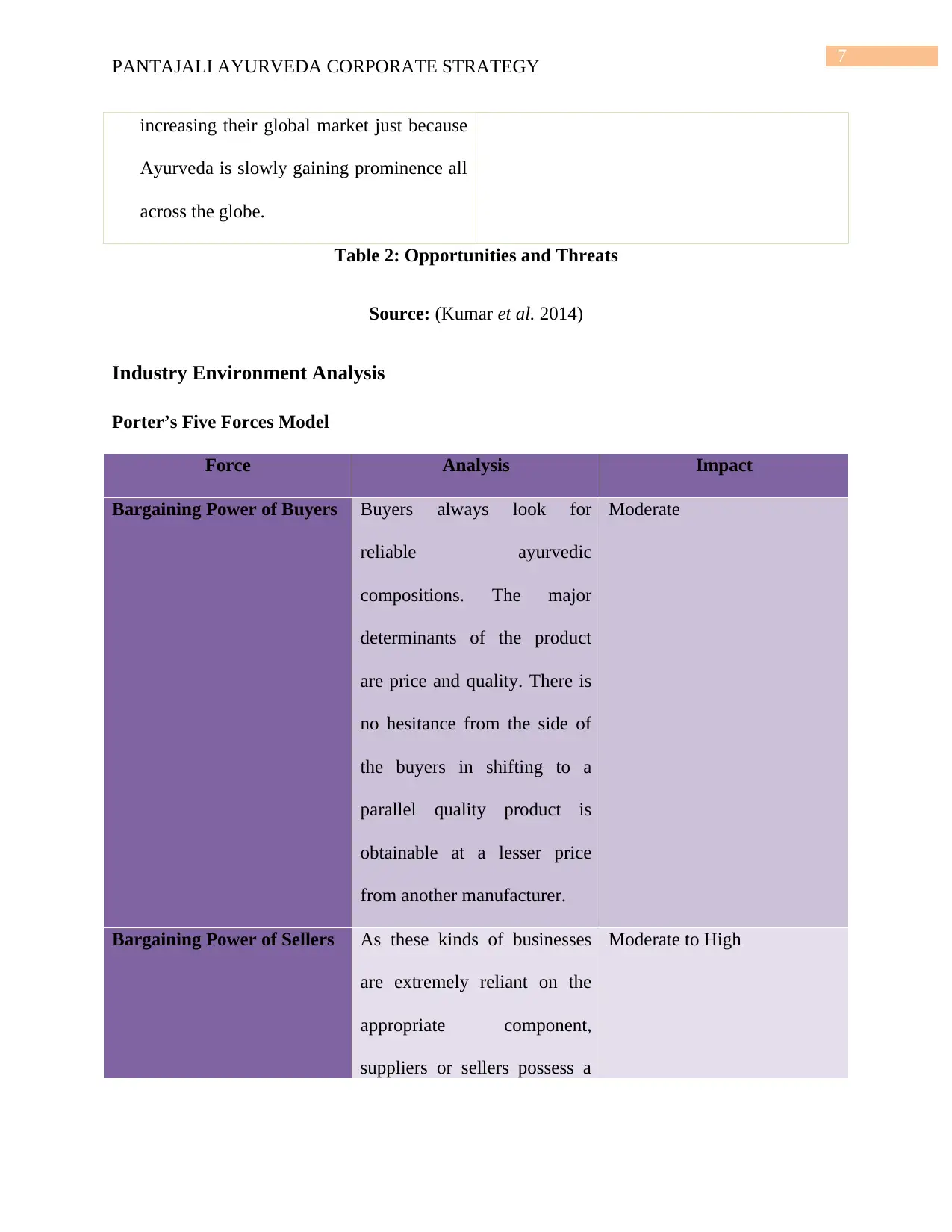
7
PANTAJALI AYURVEDA CORPORATE STRATEGY
increasing their global market just because
Ayurveda is slowly gaining prominence all
across the globe.
Table 2: Opportunities and Threats
Source: (Kumar et al. 2014)
Industry Environment Analysis
Porter’s Five Forces Model
Force Analysis Impact
Bargaining Power of Buyers Buyers always look for
reliable ayurvedic
compositions. The major
determinants of the product
are price and quality. There is
no hesitance from the side of
the buyers in shifting to a
parallel quality product is
obtainable at a lesser price
from another manufacturer.
Moderate
Bargaining Power of Sellers As these kinds of businesses
are extremely reliant on the
appropriate component,
suppliers or sellers possess a
Moderate to High
PANTAJALI AYURVEDA CORPORATE STRATEGY
increasing their global market just because
Ayurveda is slowly gaining prominence all
across the globe.
Table 2: Opportunities and Threats
Source: (Kumar et al. 2014)
Industry Environment Analysis
Porter’s Five Forces Model
Force Analysis Impact
Bargaining Power of Buyers Buyers always look for
reliable ayurvedic
compositions. The major
determinants of the product
are price and quality. There is
no hesitance from the side of
the buyers in shifting to a
parallel quality product is
obtainable at a lesser price
from another manufacturer.
Moderate
Bargaining Power of Sellers As these kinds of businesses
are extremely reliant on the
appropriate component,
suppliers or sellers possess a
Moderate to High
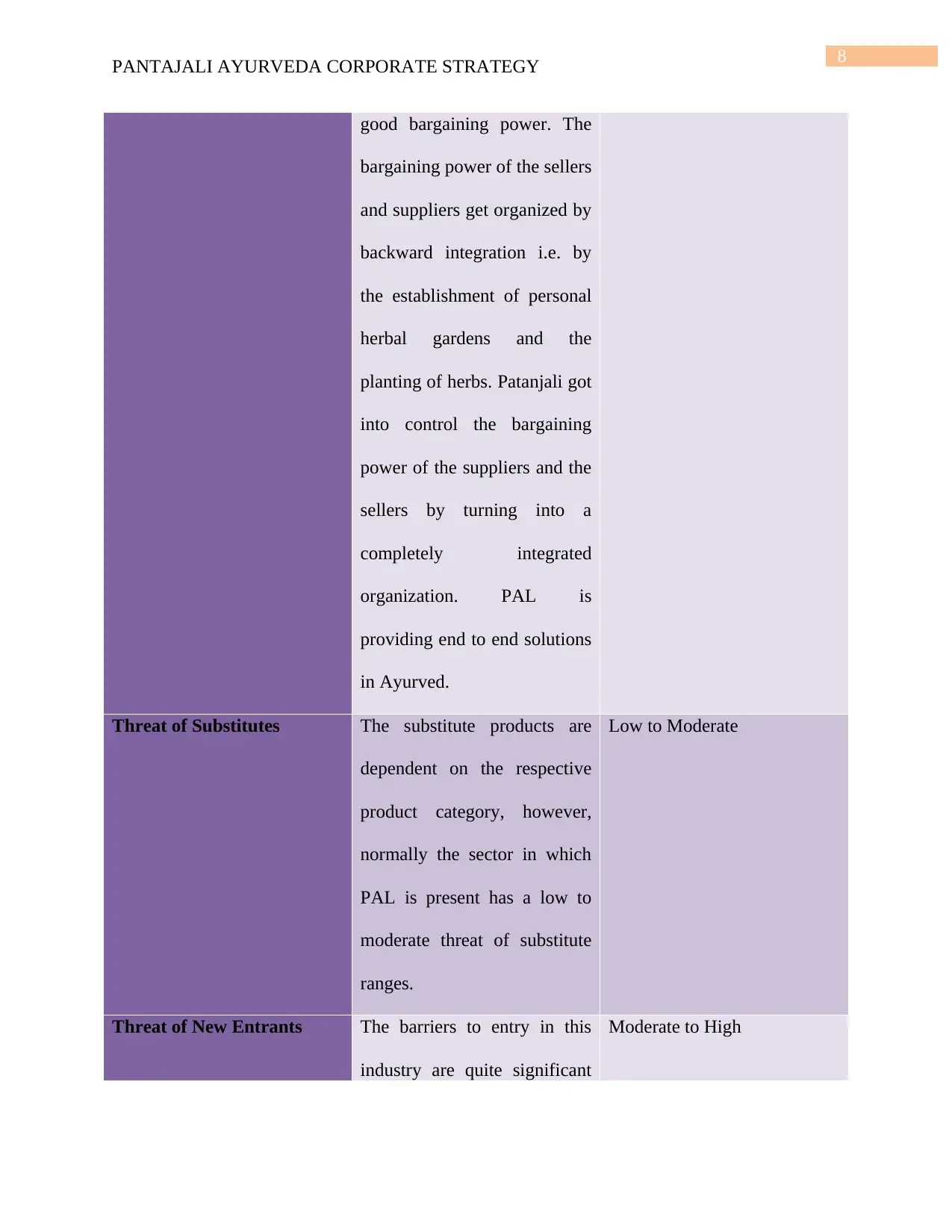
8
PANTAJALI AYURVEDA CORPORATE STRATEGY
good bargaining power. The
bargaining power of the sellers
and suppliers get organized by
backward integration i.e. by
the establishment of personal
herbal gardens and the
planting of herbs. Patanjali got
into control the bargaining
power of the suppliers and the
sellers by turning into a
completely integrated
organization. PAL is
providing end to end solutions
in Ayurved.
Threat of Substitutes The substitute products are
dependent on the respective
product category, however,
normally the sector in which
PAL is present has a low to
moderate threat of substitute
ranges.
Low to Moderate
Threat of New Entrants The barriers to entry in this
industry are quite significant
Moderate to High
PANTAJALI AYURVEDA CORPORATE STRATEGY
good bargaining power. The
bargaining power of the sellers
and suppliers get organized by
backward integration i.e. by
the establishment of personal
herbal gardens and the
planting of herbs. Patanjali got
into control the bargaining
power of the suppliers and the
sellers by turning into a
completely integrated
organization. PAL is
providing end to end solutions
in Ayurved.
Threat of Substitutes The substitute products are
dependent on the respective
product category, however,
normally the sector in which
PAL is present has a low to
moderate threat of substitute
ranges.
Low to Moderate
Threat of New Entrants The barriers to entry in this
industry are quite significant
Moderate to High
⊘ This is a preview!⊘
Do you want full access?
Subscribe today to unlock all pages.

Trusted by 1+ million students worldwide
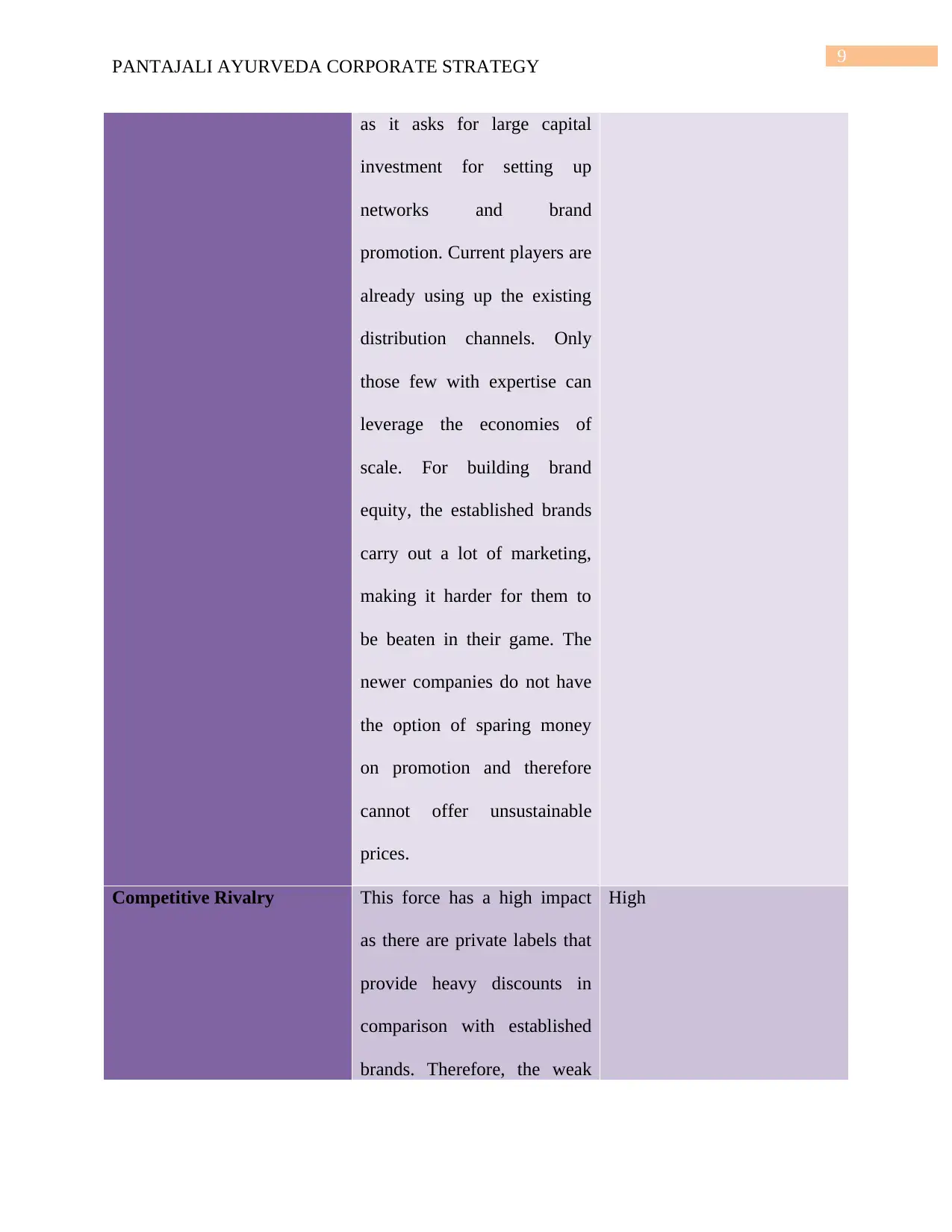
9
PANTAJALI AYURVEDA CORPORATE STRATEGY
as it asks for large capital
investment for setting up
networks and brand
promotion. Current players are
already using up the existing
distribution channels. Only
those few with expertise can
leverage the economies of
scale. For building brand
equity, the established brands
carry out a lot of marketing,
making it harder for them to
be beaten in their game. The
newer companies do not have
the option of sparing money
on promotion and therefore
cannot offer unsustainable
prices.
Competitive Rivalry This force has a high impact
as there are private labels that
provide heavy discounts in
comparison with established
brands. Therefore, the weak
High
PANTAJALI AYURVEDA CORPORATE STRATEGY
as it asks for large capital
investment for setting up
networks and brand
promotion. Current players are
already using up the existing
distribution channels. Only
those few with expertise can
leverage the economies of
scale. For building brand
equity, the established brands
carry out a lot of marketing,
making it harder for them to
be beaten in their game. The
newer companies do not have
the option of sparing money
on promotion and therefore
cannot offer unsustainable
prices.
Competitive Rivalry This force has a high impact
as there are private labels that
provide heavy discounts in
comparison with established
brands. Therefore, the weak
High
Paraphrase This Document
Need a fresh take? Get an instant paraphrase of this document with our AI Paraphraser
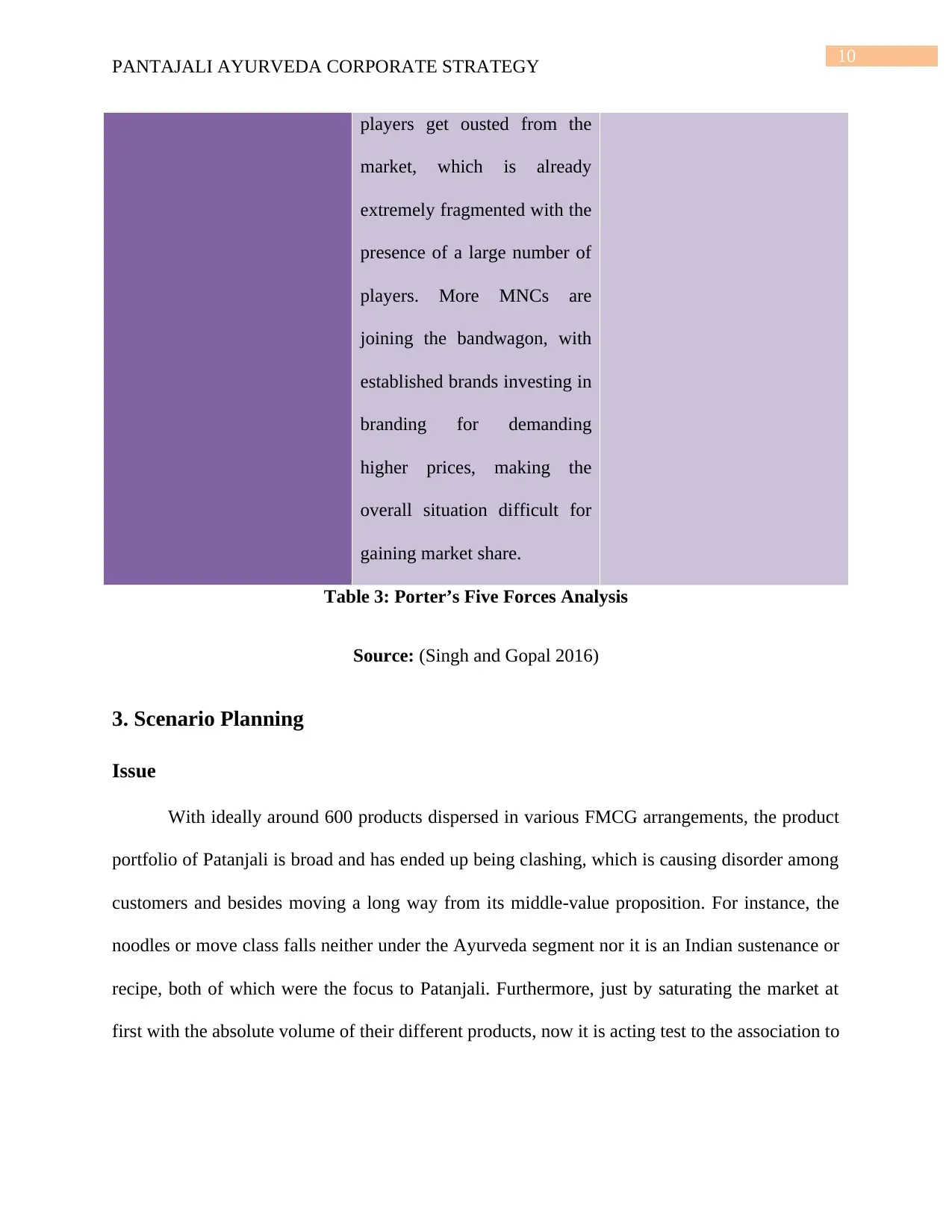
10
PANTAJALI AYURVEDA CORPORATE STRATEGY
players get ousted from the
market, which is already
extremely fragmented with the
presence of a large number of
players. More MNCs are
joining the bandwagon, with
established brands investing in
branding for demanding
higher prices, making the
overall situation difficult for
gaining market share.
Table 3: Porter’s Five Forces Analysis
Source: (Singh and Gopal 2016)
3. Scenario Planning
Issue
With ideally around 600 products dispersed in various FMCG arrangements, the product
portfolio of Patanjali is broad and has ended up being clashing, which is causing disorder among
customers and besides moving a long way from its middle-value proposition. For instance, the
noodles or move class falls neither under the Ayurveda segment nor it is an Indian sustenance or
recipe, both of which were the focus to Patanjali. Furthermore, just by saturating the market at
first with the absolute volume of their different products, now it is acting test to the association to
PANTAJALI AYURVEDA CORPORATE STRATEGY
players get ousted from the
market, which is already
extremely fragmented with the
presence of a large number of
players. More MNCs are
joining the bandwagon, with
established brands investing in
branding for demanding
higher prices, making the
overall situation difficult for
gaining market share.
Table 3: Porter’s Five Forces Analysis
Source: (Singh and Gopal 2016)
3. Scenario Planning
Issue
With ideally around 600 products dispersed in various FMCG arrangements, the product
portfolio of Patanjali is broad and has ended up being clashing, which is causing disorder among
customers and besides moving a long way from its middle-value proposition. For instance, the
noodles or move class falls neither under the Ayurveda segment nor it is an Indian sustenance or
recipe, both of which were the focus to Patanjali. Furthermore, just by saturating the market at
first with the absolute volume of their different products, now it is acting test to the association to
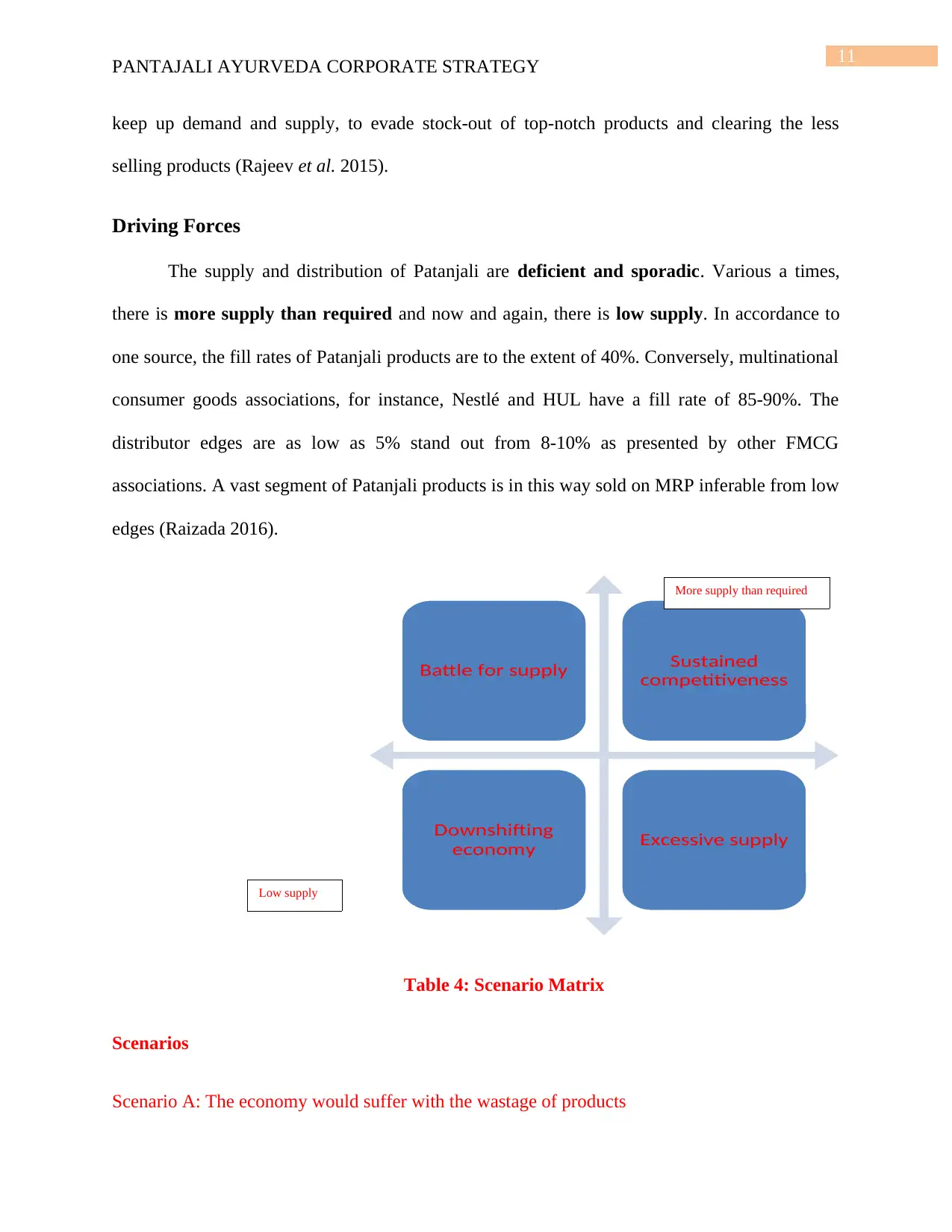
11
PANTAJALI AYURVEDA CORPORATE STRATEGY
keep up demand and supply, to evade stock-out of top-notch products and clearing the less
selling products (Rajeev et al. 2015).
Driving Forces
The supply and distribution of Patanjali are deficient and sporadic. Various a times,
there is more supply than required and now and again, there is low supply. In accordance to
one source, the fill rates of Patanjali products are to the extent of 40%. Conversely, multinational
consumer goods associations, for instance, Nestlé and HUL have a fill rate of 85-90%. The
distributor edges are as low as 5% stand out from 8-10% as presented by other FMCG
associations. A vast segment of Patanjali products is in this way sold on MRP inferable from low
edges (Raizada 2016).
Table 4: Scenario Matrix
Scenarios
Scenario A: The economy would suffer with the wastage of products
Battle for supply Sustained
competitiveness
Downshifting
economy Excessive supply
More supply than required
Low supply
PANTAJALI AYURVEDA CORPORATE STRATEGY
keep up demand and supply, to evade stock-out of top-notch products and clearing the less
selling products (Rajeev et al. 2015).
Driving Forces
The supply and distribution of Patanjali are deficient and sporadic. Various a times,
there is more supply than required and now and again, there is low supply. In accordance to
one source, the fill rates of Patanjali products are to the extent of 40%. Conversely, multinational
consumer goods associations, for instance, Nestlé and HUL have a fill rate of 85-90%. The
distributor edges are as low as 5% stand out from 8-10% as presented by other FMCG
associations. A vast segment of Patanjali products is in this way sold on MRP inferable from low
edges (Raizada 2016).
Table 4: Scenario Matrix
Scenarios
Scenario A: The economy would suffer with the wastage of products
Battle for supply Sustained
competitiveness
Downshifting
economy Excessive supply
More supply than required
Low supply
⊘ This is a preview!⊘
Do you want full access?
Subscribe today to unlock all pages.

Trusted by 1+ million students worldwide
1 out of 21
Related Documents
Your All-in-One AI-Powered Toolkit for Academic Success.
+13062052269
info@desklib.com
Available 24*7 on WhatsApp / Email
![[object Object]](/_next/static/media/star-bottom.7253800d.svg)
Unlock your academic potential
Copyright © 2020–2025 A2Z Services. All Rights Reserved. Developed and managed by ZUCOL.




